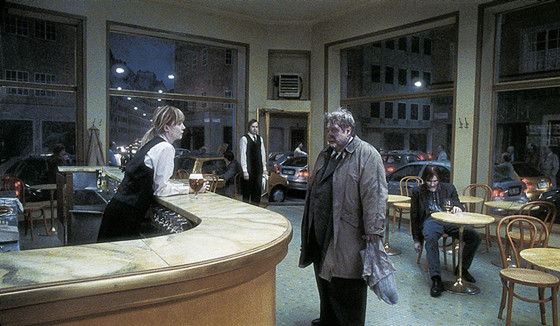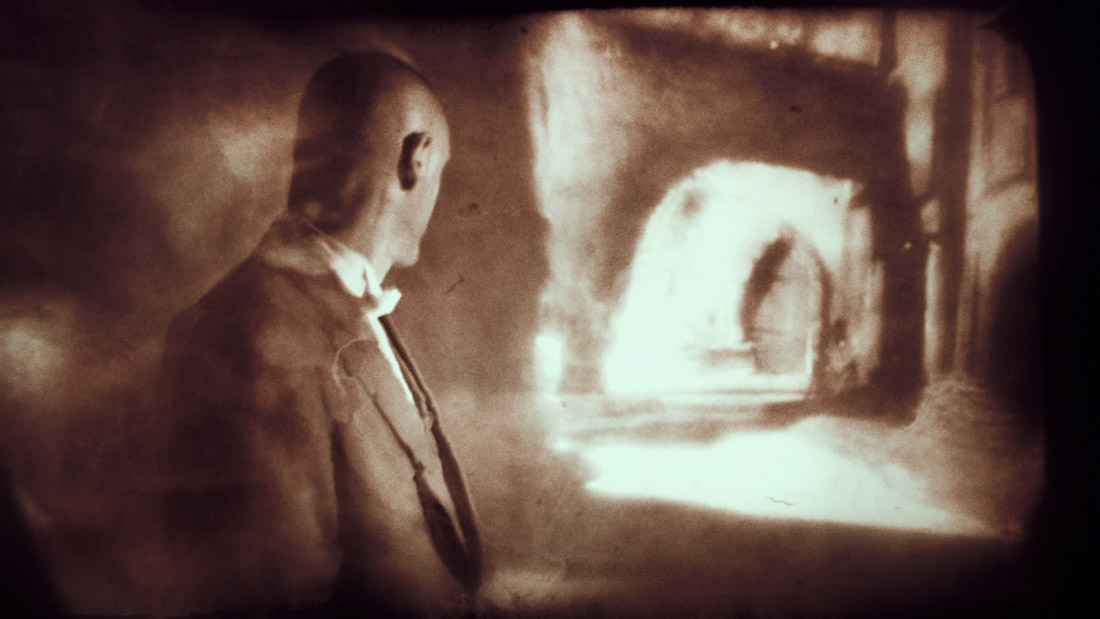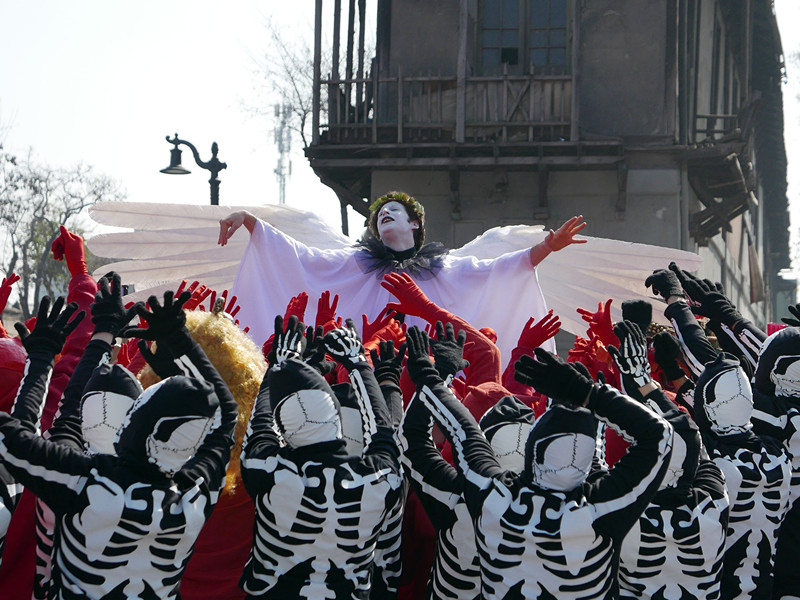5. Starfish (2018)

We all need something to believe in these days – something that drives us and keeps us focused in our solitude or we are bound to go mad. Starfish opens with Aubrey (committedly portrayed by Virginia Gardner) attending the funeral of her best friend Grace (Christina Masterson). She retreats to Grace’s apartment in isolation to reflect and to remember. With her expressive face and lethargic physicality, Gardner tacitly conveys the deep emotions of her character’s melancholy.
The next morning , Aubrey awakens to a very different world outside. Snow has fallen and everyone in the town (and maybe the world) has vanished. Even if you are tempted, do not research why this has occurred as this surprise is the crux of Starfish. Grace somehow foresaw these changes and had left clues for Aubrey sending her on a treasure hunt to find a series of audio cassettes. Aubrey needs to decode these mixtapes leading her to a possible solution to save the world.
Gardner acts the majority of Starfish on her own, but she pulls off this onerous task brilliantly. Director A.T. White quietly surprises his audience with moody cinematography, laudable special effects (while seemingly on a budget) and he even breaks the fourth wall adding to the surreal quality of this film. Starfish is a story about solitude, mourning, loss, moving on, and how we deal with these life events. During a time when many people are forced into isolation with too much time to reflect, this film will surely have an impact on and resonate with today’s audiences.
4. Songs from the Second Floor (2000)

In 2000, Swedish director Roy Anderson embarked on “The Living Trilogy” with its first installment entitled Songs from the Second Floor. It would then be followed up in 2007 with You the Living and then completed in 2014 with A Pigeon Sat on a Branch Reflecting on Existence. This absurdist trio of films sets the same droll mood throughout. While slow in regards to real action, watching them unfold before your eyes is hypnotic. They are the visual representation of a Steven Wright joke – they are slow, understated, make you think, and are quite funny.
Each vignette is loosely connected to the arc of the film and is a mini-commentary on modern society, human nature, and existence. J. Hoberman of the Village Voice succinctly described this film with the apt dichotomy “slapstick Ingmar Bergman.”
Throughout Songs from the Second Floor, actors’ faces appear ashen with vacant expressions, there is a flat and muted color scheme, and scenes are shot with a wide-angle lens in crisp focus from foreground to background. Anderson enhances the feeling of a photograph by utilizing a static camera and very long takes. The film resembles a long, dark, Swedish winter where the deadpan comedy and universal, human experience both supply the much-needed sunlight.
3. The Forbidden Room (2015)

One of the lesser-known masters of contemporary cinema is Canada’s visionary director Guy Maddin. His most noticeable trait onscreen is his affinity for silent and early sound films. Maddin incorporates devices such as intertitles, irises, dialogue cards, color tinting, melodramatic acting, rear projection, and other effects purposely used to make the film appear wonderfully dated. All of these techniques are brilliantly incorporated even though The Forbidden Room was shot digitally. While he reveres the silent era, this film has sound and Maddin uses it hauntingly, adding to the overall effect of this wild, cinematic ride. The comedically low-budget approach mixed with layered, visual creativity gives The Forbidden Room an incomparable look.
The plot, you ask? As the saying goes, “it’s complicated”. We are taken through an amalgam of 18 threads inspired by titles of lost films from the 1920s and 1930s. They interweave one into the next and then back again three different times like “Russian nesting dolls”, as Maddin described it, to create a dizzying saga. The first thread is launched with a laughable segment on how to take baths and then jumps to a submarine crew that is running short on air. As “logic” has it, the sailors get more oxygen by eating pancakes with air bubbles suspended within them! From there, it only gets more outlandish. This labyrinthine film utilizes fine, recognizable actors including Geraldine Chaplin, Charlotte Rampling and Udo Kier. With a running time of nearly two hours, The Forbidden Room is replete with excess, so if you happen to lose focus, something unexpected will soon catch your eye.
2. Endless Poetry (2016)

Chilean director Alejandro Jodorowsky’s visionary mind has graced the silver screen with films that resemble no others. At 91 years of age, he is truly a modern-day, Renaissance man having produced works in the disciplines of poetry, cinema, theater, literature, music, painting, puppetry, philosophy, and countless others. Such film as his Holy Mountain and El Topo conjure up opulently mystical images with deeply symbolic and often religious meanings.
In Endless Poetry, we have a master artist looking back on his long road of creativity to where it all began back in Chile in the 1940s. We see how Jodorowsky overcame the challenges of life and his surroundings in order to achieve his goals. While the imagery is less over the top than his more mind-bending films of the 1970s, it is nevertheless pure Jodorowsky. He has aged like a fine wine and the rough edges of youth have been softened. In this film, there is a mixture of playful, magical, Fellini-like moments that contrast the more jarringly Jodorowsky ones that we have come to expect, but his use of symbolism remains as strong as ever. All cinephiles should experience Jodorowsky’s craft and vision and Endless Poetry is a fine place to start.
1. The Cremaster Cycle (1994-2002)

Where to begin? Well, how about the title? The cremaster is a muscle whose function is to raise and lower the testes to regulate the optimum temperature level of the sperm within them. Now that you know this bit of biological trivia, director and artist Matthew Barney created The Cremaster Cycle which is five, otherworldly films of varying length from 40 minutes to 3 hours. They are more performance art than narrative, but contained within these vexing works are some of the most original and bold images put to film. We are shown superbly bizarre make-up effects, Busby Berkeley-like choreography, symbolism of reproductive biology, an extended sequence splendidly shot in the NYC Guggenheim Museum, and MUCH more.
Production values vary throughout the series, but the inventiveness never wanes. These films place their spectators in a one-of-a-kind world where there is little dialogue, yet the experience of watching these surreal images is deeply rewarding. The riddles onscreen keep viewers’ minds active by constantly challenging them to decipher what they are beholding. That being said, reading a synopsis/analysis will enhance your viewing by helping you navigate these baffling films.
If none of what I have said makes any sense, it is because you need to see these films to believe and (try to) understand them. It used to be nearly impossible to view the Cremaster films outside of an art gallery, but even though it is not optimum, all five films are remarkably available on YouTube.